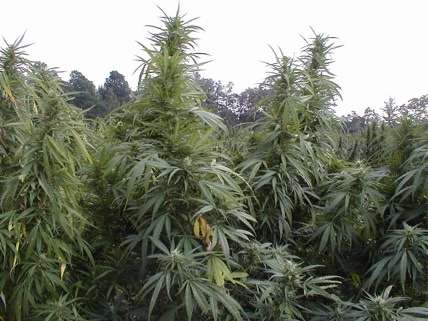Commercial Cannabis Cultivators in Colorado Move Outdoors
Using sunlight instead of electric lights could cut the price of pot in half.


It's scientifically proven that marijuana increases users' consumption of (or at least desire for) junk food.
On the supply side, pot cultivation also increases consumption—of electricity. Growing pot indoors requires power-sucking lights and climate-control systems. In Denver, almost half of the city's year-over-year increase in electricity use has come from its hundreds of new indoor pot farms.
As ReasonTV reported from Colorado's Cannabis Business Summit (video below), innovators in the industry are working to combat this exorbitant energy usage by supplying low-power LED grow lights.
"Most lighting that's used in the cannabis industry right now is standardized on 1,000-watt high-pressure sodium bulbs," said Kevin Frender of Black Dog LED. Frender claims his company's LED lighting rigs use 30 percent less electricity.
But some commercial growers in Pueblo County, Colorado, are putting their facilities on an electron diet by taking their grows outside, according to NBC affiliate station KOAA:
"In the past, when I had a 2,500 square foot warehouse and once we flicked on half of the building, maybe three quarters of it, we were looking at costs to about $30 to $50 grand a month just in electric," said Jim Bent, Vice President of Operations at Emerald Fields.
But there is a shift in how businesses are growing their marijuana. Emerald Fields now has literal fields of plants at their new 28 acre outdoor facility, and they plan to open up grow houses nearby for other businesses to use.
Outdoor (or greenhouse-style) facilities require beefier security, but for commercial pot farmers like Bent, the tradeoff is worth it:
Bent said the benefits are two-fold: reducing their carbon footprint and saving money.
"Not only does it help the environment but it also helps you increase your sales because your cost per gram is a lot cheaper using green houses or outside methods of growing versus indoors with all the electricity and so forth," he said.
Those cost savings and increased sales could drastically reduce the price of legal cannabis. In Reason's November 2014 issue, Jacob Sullum reported that high retail prices, resulting from taxes and regulations imposed on the industry, have kept Colorado's black market for pot in business:
Many consumers balk even at those prices, which helps explain why the black market persists in Colorado in spite of legalization. How long that situation will last is an important question for Colorado and for other states that are considering following its example, since eliminating the black market is one of legalization's main selling points.
Colorado has yet to see eighths selling for $10–$15, as predicted by one pot retailer Sullum interviewed for the piece. But as more commercial growers shut off the lights and move outdoors, prices should continue to fall, benefiting consumers and reducing black-market sales.
Check out ReasonTV's video from the recent Cannabis Business Summit:

Show Comments (14)